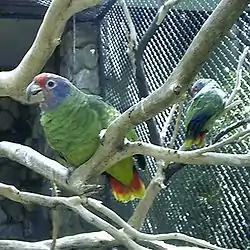Arinae
Los loros neotropicales (Arinae) son una de las dos subfamilias de aves psitaciformes pertenecientes a la familia Psittacidae,[1][2] cuyos miembros habitan en América. La subfamilia está compuesta por todos los loros típicos (Psittacoidea) que habitan en la región neotropical.
| Arinae | ||
|---|---|---|
 | ||
| Taxonomía | ||
| Reino: | Animalia | |
| Filo: | Chordata | |
| Clase: | Aves | |
| Orden: | Psittaciformes | |
| Superfamilia: | Psittacoidea | |
| Familia: | Psittacidae | |
| Subfamilia: |
Arinae G.R. Gray, 1840 | |
| Tribus | ||
Se compone de dos grupos principales (tribus Arini y Androglossini) cuyas especies se diferencian fácilmente por tener la cola larga o corta,[3] respectivamente, y que a su vez se clasifican en 32 géneros existentes en época moderna. Aunque se conocen bastante pocos fósiles de loros, la mayoría pertenecen a la tribu Arini y muestran que los géneros modernos se empezaron a diferenciar en el Pleistoceno, hace solo unos pocos millones de años.
Taxonomía
La taxonomía del grupo no está plenamente resulta, pero la siguiente clasificación es respaldada por los estudios más sólidos.[4][5][6][7][8][9][10]
- Tribu Arini
- Género Cyanoliseus
- Género Enicognathus
- Género Rhynchopsitta
- Género Pyrrhura
- Género Anodorhynchus
- Género Leptosittaca
- Género Ognorhynchus
- Género Diopsittaca
- Género Guarouba
- Género Conuropsis (extinto)
- Género Cyanopsitta
- Género Orthopsittaca
- Género Ara
- Género Primolius (3 especies anteriormente en Propyrrhura)
- Género Aratinga
- Género Psittacara
- Género Pionus
- Género Nandayus
- Género Thectocercus
- Género Eupsittula
- Tribu Androglossini
- Género Pionopsitta
- Género Triclaria
- Género Pyrilia (7 especies anteriormente situadas en Pionopsitta).
- Género Graydidascalus
- Género Alipiopsitta (anteriormente en Amazona, Salvatoria)
- Género Amazona
- Incertae sedis
- Género Pionites (2 especies)
- Género Deroptyus (1 especie)
- Género Hapalopsittaca (4 especies)
- Género Nannopsittaca (2 especies)
- Género Psilopsiagon (2 especies, anteriormente en Bolborhynchus)
- Género Bolborhynchus (3 especies)
- Género Touit (8 especies)
- Género Brotogeris (8 especies)
- Género Myiopsitta (1-2 especies)
- Género Forpus (7 especies)
Referencias
- Leo Joseph, Alicia Toon, Erin E. Schirtzinger, Timothy F. Wright, Richard Schodde. 2012. A revised nomenclature and classification for family-group taxa of parrots (Psittaciformes) Archivado el 11 de diciembre de 2013 en Wayback Machine. ISSN 1175-5326 Zootaxa 3205: 26–40.
- http://jboyd.net/Taxo/List12.html#psittaciformes
- Miyaki et al. (1998)
- Leo Joseph, Alicia Toon, Erin E. Schirtzinger, Timothy F. Wright & Richard Schodde. (2012) A revised nomenclature and classification for family-group taxa of parrots (Psittaciformes). Zootaxa 3205: 26–40
- Nicole E. White, Matthew J. Phillips, M. Thomas P. Gilbert, Alonzo Alfaro-Núñez, Eske Willerslev, Peter R. Mawson, Peter B.S. Spencer, Michael Bunce (2011). «The evolutionary history of cockatoos (Aves: Psittaciformes: Cacatuidae)». Molecular Phylogenetics and Evolution 59: 615-622. PMID 21419232. doi:10.1016/j.ympev.2011.03.011.
- Manuel Schweizer, Ole Seehausen and Stefan T. Hertwig (2011). «Macroevolutionary patterns in the diversification of parrots: effects of climate change, geological events and key innovations». Journal of Biogeography 38: 2176-2194. doi:10.1111/j.1365-2699.2011.02555.x.
- Leo Joseph, Alicia Toon, Erin E. Schirtzinger, Timothy F. Wright (2011). «Molecular systematics of two enigmatic genera Psittacella and Pezoporus illuminate the ecological radiation of Australo-Papuan parrots (Aves: Psittaciformes)». Molecular Phylogenetics and Evolution 59: 675-684. PMID 21453777. doi:10.1016/j.ympev.2011.03.017.
- Wright, T.F.; Schirtzinger E. E., Matsumoto T., Eberhard J. R., Graves G. R., Sanchez J. J., Capelli S., Muller H., Scharpegge J., Chambers G. K. & Fleischer R. C. (2008). «A Multilocus Molecular Phylogeny of the Parrots (Psittaciformes): Support for a Gondwanan Origin during the Cretaceous». Mol Biol Evol 25 (10): 2141-2156. PMC 2727385. PMID 18653733. doi:10.1093/molbev/msn160.
- Schweizer, M.; Seehausen O, Güntert M and Hertwig ST (2009). «The evolutionary diversification of parrots supports a taxon pulse model with multiple trans-oceanic dispersal events and local radiations». Molecular Phylogenetics and Evolution. online. PMID 19699808. doi:10.1016/j.ympev.2009.08.021.
- de Kloet, RS; de Kloet SR (2005). «The evolution of the spindlin gene in birds: Sequence analysis of an intron of the spindlin W and Z gene reveals four major divisions of the Psittaciformes». Molecular Phylogenetics and Evolution 36: 706-721. PMID 16099384. doi:10.1016/j.ympev.2005.03.013.
Bibliografía
- Miyaki, C. Y.; Matioli, S. R.; Burke, T. & Wajntal, A. (1998): Parrot evolution and paleogeographical events: Mitochondrial DNA evidence. Molecular Biology and Evolution 15: 544-551. PDF fulltext
- Ribas, C., R. Gaban-Lima, C. Miyaki, and J. Cracraft (2005). Historical biogeography and diversification within the Neotropical parrot genus Pionopsitta (Aves: Psittacidae). Journal Biogeography 32:1409-1427.
- Split Gypopsitta from Pionopsitta South American Classification Committee.